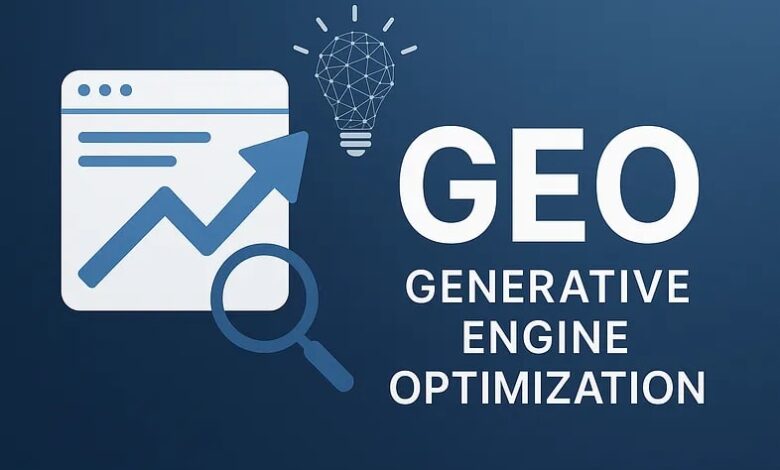What Is “Generative Engine Optimization” — and Why Everyone’s Talking About It

The way people search for information online is changing fast, thanks to artificial intelligence (AI). Instead of just seeing a list of web pages ranked by keywords, many users now get direct answers from AI-driven platforms like ChatGPT, Google Gemini, and Perplexity. This shift means how businesses and websites get found online must change, too.
This is where Generative Engine Optimization (GEO) comes in. Simply put, GEO is about adjusting your content and website so AI search engines understand you better and cite your brand in the answers they provide to users. Not just aiming for traditional Google rankings anymore, but also making sure your brand shines in AI-driven results.
In this article, we’ll explain what generative engine optimization is, why it matters right now, how it differs from regular SEO, how it works, key strategies to implement it, and its advantages and disadvantages for businesses. By the end, you’ll see why everyone’s talking about GEO and why it’s crucial for staying visible in the future of online search.
What Is Generative Engine Optimization (GEO)?
Generative Engine Optimization, or GEO, refers to the process of optimizing your website and its content so it can be discovered, understood, and used by AI-driven search tools.
Unlike traditional SEO that focuses mainly on getting websites to rank high in search engines like Google through keywords and backlinks, GEO aims to make your content visible in AI-generated answers.
AI search platforms such as ChatGPT, Google Gemini, Perplexity, and others work differently from normal search engines. Instead of showing a list of links, they use large language models (LLMs) that can understand the context and meaning behind queries and generate clear, concise answers by summarizing information from many sources.
GEO is about tailoring your content to meet these AI engines’ needs, helping them to include your brand in their real-time generated responses. So, in essence, GEO is optimizing for the future of search, where AI-powered answers dominate instead of just plain webpage rankings.
Read Next: Social Media in 2025: Top Platforms That Still Matter
Why GEO Matters Now
Before diving deeper, it’s important to understand why GEO is becoming a big deal today.
AI-driven search tools are growing rapidly in popularity. For example, ChatGPT alone has overtaken traditional search engines like Bing in the number of daily queries. More people now prefer getting instant, direct answers from AI rather than clicking through a list of links.
This means the user behavior is shifting – fewer clicks on websites and more reliance on AI-generated summaries. For businesses, it’s not enough to just rank well on Google anymore. Your brand needs to be recognized and cited by these AI systems, which can boost your visibility and authority in new ways.
GEO allows brands to grab attention in this evolving landscape, increasing brand awareness through AI citations and ensuring you reach users even when they are not clicking traditional search result pages. This makes GEO a critical strategy to stay relevant in 2025 and beyond.
Differences Between GEO and Traditional SEO
Before we compare, note that while GEO builds on SEO principles, it requires a fresh approach tailored for AI-driven search.
| Aspect | Traditional SEO | Generative Engine Optimization (GEO) |
| Goal | Rank high on traditional search engines like Google | Get cited in AI-generated summaries and answers |
| Result Format | Webpages ranked by keywords | AI-generated responses that summarize multiple sources |
| User Interaction | Users click links to visit web pages | Users receive direct, conversational answers |
| Content Style | Keyword-heavy, using lengthy content | Clear, concise, structured content fit for snippets |
| Performance Metrics | Traffic and conversion rates | Frequency of AI citations and mentions |
Traditional SEO is still about attracting clicks by boosting placement on search engine results pages (SERPs). GEO focuses on content that AI engines can easily understand and use in real-time answers, where users may never click through to your site but still see your brand included.
In other words, SEO aims to get users to visit your site, while GEO aims to have your brand’s information delivered directly within AI responses.
How Does GEO Work?
Let’s explore how GEO puts theory into practice.
GEO starts with creating clear, well-structured, and authoritative content. AI search engines perform best when content is easy to read, logically organized, and factual.
Here are the key components:
- Content Format: Write in a Q&A or concise paragraph style with clear headings; this helps AI engines quickly locate useful information.
- Technical Optimization: Implement schema markup (special code on your site) that provides AI with explicit details about your content’s context.
- Credibility Building: Build trust by gaining backlinks from reputable sites and maintaining up-to-date corporate profiles, reviews, and resources.
- Monitor AI Citations: Instead of just tracking keyword ranks, businesses now track how often AI engines cite their content.
- Ongoing Updates: AI models evolve, so content must be regularly reviewed and improved to maintain alignment with AI algorithms.
Basically, GEO ensures AI models can find, read, and confidently reference your content in answers to users’ questions.
Read Next: How to Use Customer Reviews to Boost Sales
Key Strategies for Implementing GEO
With a good grasp of how GEO works, here are essential strategies to implement it:
- Write Concise, Relevant Content Focused on User Intent
Understand what users really want to know and answer those queries clearly and precisely. - Use Schema Markup
Use structured data to help AI understand content relationships, like products, people, reviews, or FAQs. - Enhance Technical Site Health
Ensure your site loads quickly, is mobile-friendly, and easy for AI bots to crawl. - Build Brand Authority
Publish expert, trustworthy information and actively manage your brand presence online (e.g., maintain Wikipedia pages, product reviews). - Track AI Citation Feedback
Use tools or AI analytics to monitor how often AI engines cite your content and refresh pages accordingly.
These steps make sure your website content not only appeals to human readers but also fits the needs of AI-driven search platforms.
The Role of Natural Language Processing (NLP) and AI in GEO
A big reason GEO differs so much from SEO is the power of AI and its language understanding ability.
Natural Language Processing (NLP) lets AI understand human language, not just keywords. It grasps context, intent, and semantics, meaning it can figure out what users really mean and give answers using content from many sources.
This ability means your GEO-optimized content must be semantically rich, that is, written with clear meaning, natural language, and connected ideas, so AI can extract useful answers easily.
AI also generates responses in real time, blending info from multiple trusted sources and personalizing answers based on user context. So GEO content must be trustworthy and structured in a way AI can comprehend beyond keywords.
Advantages of GEO for Businesses
Before listing, consider this: adopting GEO means embracing the future of search.
Some key advantages include:
- Increased Visibility in AI Search Platforms: As more users get answers from AI engines, appearing there expands your digital footprint.
- Direct User Engagement: Getting cited directly in AI answers builds trust and can drive brand consideration.
- Stay Relevant as Search Evolves: Search behavior is changing fast; GEO helps businesses keep up and avoid losing traffic.
- Complements Traditional SEO: GEO isn’t replacing SEO but works alongside it for a more complete online presence.
By investing in GEO, businesses can remain competitive in the fast-changing world of AI-powered search.
Disadvantages of GEO for Businesses
Despite its benefits, GEO also has challenges:
- Less Direct Website Traffic: Since AI answers reduce clicks, businesses might see fewer visits, affecting ad revenue or conversions relying on site traffic.
- Dependence on AI Platform Algorithms: AI engines control the citation criteria, which can change unpredictably, making results unstable.
- New Skillsets Needed: GEO requires understanding AI technology and content strategies that differ from traditional SEO, which can demand new expertise or resources.
- Data Privacy and Control: Brands might worry about how their content is used or how user data influences AI responses.
Balancing GEO alongside SEO is important to manage these downsides effectively.
Read Next: Best AI Tools for Small Business Marketing in 2025
Conclusion
Generative Engine Optimization (GEO) is no longer a futuristic idea, it’s here, transforming how people find and interact with information online. As AI-driven search tools like ChatGPT and Google Gemini become the go-to way to answer questions, GEO allows businesses to stay visible, authoritative, and engaging in this new search era.
While traditional SEO remains valuable, embracing GEO principles ensures your brand is part of AI-generated answers, increasing awareness and trust. Start optimizing your content with GEO strategies today to stay ahead as search continues to evolve toward AI.
Frequently Asked Questions (FAQs)
1. What exactly is Generative Engine Optimization?
GEO is the process of optimizing your website content to be discovered and cited by AI-driven search engines that provide real-time, generated answers instead of just a list of web links.
2. How is GEO different from traditional SEO?
Traditional SEO focuses on ranking websites in search engine results, while GEO focuses on making content understandable and trustworthy for AI to include it directly in its generated answers.
3. Why should businesses care about GEO today?
Because many users now rely on AI tools for instant answers, GEO helps brands remain visible and authoritative in these AI-generated responses, reaching users in new ways.
4. What are some key ways to optimize for GEO?
Writing clear and relevant content aimed at user questions, using schema markup, improving site speed and mobile experience, building brand trust, and continuously updating content based on AI citation feedback.



